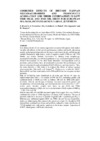Identificador persistente para citar o vincular este elemento:
https://accedacris.ulpgc.es/jspui/handle/10553/72068
| Título: | Combined effects of dietary mannan oligosaccharides and Pediococcus acidilactici and their combination in low fish meal and fish oil diets for European sea bass, Dicentrarchus labrax, juveniles | Autores/as: | Rivero, F. Torrecillas Burriel,Silvia Caballero Cansino, María José Makol, A. Izquierdo, Marisol Montero Vítores, Daniel |
Clasificación UNESCO: | 251092 Acuicultura marina | Palabras clave: | Dicentrarchus Labrax Immunostimulants Probiotics ISH GALT |
Fecha de publicación: | 2016 | Editor/a: | Elsevier | Proyectos: | Complementos Dieteticos en la Utilización de Lipidos Alternativos Al Aceite de Pescado en Acuicultura Marina: Herramienta Para Maximizar El Potencial de Resistencia A Patogenos | Publicación seriada: | Fish and Shellfish Immunology | Conferencia: | 2nd Conference of the International Society of Fish & Shellfish Immunology. ISFSI 2016 | Resumen: | Low dietary levels of raw marine ingredients in marine fish species diets induce variable side-effects on fish growth performance, welfare and health, depending mainly on the terrestrial protein and oil source used, dietary levels and fish species studied. Particularly, high dietary levels of vegetable meals (VM) and oils (VO) blends, may induce intestinal dysfunction by altering tissue morphology, intestinal functionality, microbiota populations or gut associated lymphoid tissue (GALT) homeostasis. On the other hand, alternative feed ingredients such as prebiotics and probiotics have demonstrated to promote fish performance and disease resistance through potentiating GALT efficiency and functionality. Thus, the main objective of this study is to evaluate the effects of dietary mannan oligosaccharides (Biomos® and ActigenTM), Pediococcus acidilactici (BAC; Bactocell ®) and their combination in low FM and FO diets for european sea bass juveniles. Fish of 19.7±0.09g were distributed in 18 tanks and fed for 90 days six experimental diets with a low content of FM and FO, containing graded and combined levels of MOS and BAC as follows: HP; LP; B; HPB; LPB and C (Control). After 60 and 90 days of feeding, fish were sampled for growth, gut morphometry and histopathology, gut mucus production and expression of GALT related genes. Besides, samples were taken for gut iNOS and TNFα immunohistochemistry (IHQ) and for in situ hybridation (ISH) studies of MHCβ, TCRβ, CD4 and CD8. Fish fed diets HP, LP and LPB presented higher final weight. Two-way ANOVA attributed this effect to MOS regardless of dietary BAC inclusion. The use of prebiotic induced an increase on number of goblet cells in posterior gut (Fig.1). IHQ analyses performed against iNOS and TNFα showed the use of prebiotics induce an inflammatory-like pattern in the apical side of gut villi. Results for ISH showed that combined use of pre and probiotic induced a wider distribution of TCR-β marked cells, with special emphasis in the lamina propria. Expression of GALT-related genes, will be also discussed. Fig.1. Posterior gut (Alcian Blue-PAS). (a) LPB and (b) C diets t=90days. Note the higher number of goblet cell for fish fed LPB diet Acknowledgements: This study has been funded by the Spanish Ministry of Economy and Competitiveness, Project AGL2012-39919 (PROINMUNOIL). This study evaluates the effects of dietary mannan oligosaccharides (MOS) on growth, tissue composition, fatty acid profiles and liver morphology of European sea bass (Dicentrarchus labrax) fed diets containing either soybean oil (SBO; SBOMOS) or fish oil (FO; FOMOS) as unique oil source for 8 weeks. Results showed that MOS supplementation enhanced specific growth rate, regardless of the oil source used, and that dietary oil source reduced fish length, regardless of dietary MOS supplementation. Dietary MOS favoured lipid accumulation in muscle and anterior intestine when supplemented in FO‐based diets compared to fish fed SBO diet and reduces it in liver in relation to lower hepatocyte area, particularly in fish fed SBOMOS diet. Dietary MOS favoured liver and not muscular ∑n‐3 PUFA, DHA, EPA and ARA deposition, when combined with FO but not when included in SBO‐based diets. Thus, MOS dietary supplementation favours fish performance and helps to minimize the side effects derived from high dietary SBO supplementation on liver lipid accumulation and hepatocyte vacuolization, which could be of especial interest on long‐term feeding trials; however, the effects on favoured deposition ∑n‐3 PUFA are limited to FO‐based diets. |
URI: | https://accedacris.ulpgc.es/handle/10553/72068 | ISSN: | 1050-4648 | DOI: | 10.1016/J.FSI.2016.03.075 | Fuente: | Fish & Shellfish Immunology [ISSN 1050-4648], v. 53, p. 69, Abstract O-032, (Junio 2016) |
| Colección: | Actas de congresos |
Visitas
208
actualizado el 27-sep-2025
Descargas
116
actualizado el 27-sep-2025
Google ScholarTM
Verifica
Altmetric
Comparte
Exporta metadatos
Los elementos en ULPGC accedaCRIS están protegidos por derechos de autor con todos los derechos reservados, a menos que se indique lo contrario.
